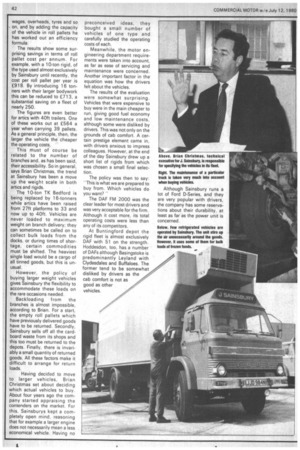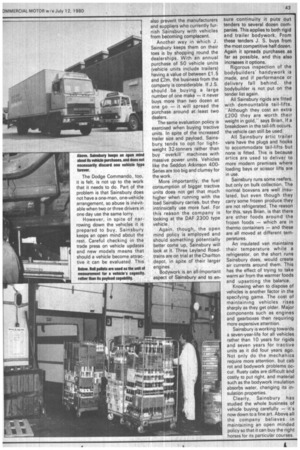Right specs bring home the bacon
Page 43

Page 44

Page 45

If you've noticed an error in this article please click here to report it so we can fix it.
Sainsbury finds that brand choice is as important out in the transport yard as it is on the shelves By Steve Gray
;PECIFYING the right vehicle Dr the job has always been a roblem, but in these days of Jnaway inflation it is turning ito a nightmare.
The problem is not just a luestion of getting the right iardware; today's vehicle luyers have far wider implicaions to take into their calculaions. With the high cost of borowing money, a careful balan,ing act must be performed )etween the initial cost of the rehicle, its likelji useful life and ts performance in terms of runling costs.
Can, for example, a higher )urchase price be totally .ecouped by lower operating :osts, or will the interest potential of the capital employed be greater?
For many it is a vexing question and to a large extent it becomes something of a gamble, especially for the own-account operator whose prime concern is really to make and sell his goods rather than run vehicles. Nevertheless, it is the own-account side of the business which has been quick to adopt a professional and scientific approach to vehicle specifying.
To these operators, of course, higher transport costs mean a higher price for their goods, which in turn makes them less competitive.
It could be argued, though, that it is the same for everyone. Perhaps the own-account man who can save money on his transport is better placed to succeed, So I visited J. Sainsbury Ltd, the retail food and grocery chain, and spoke to its technical executive, Brian Christmas, in order to find out how one such operator deals with the complex problems of vehicle specification.
J. Sainsbury is a good example of an established, own-account business which by necessity has to run its own transport fleet, delivering groceries and produce to nearly 250 shops, freezer centres and more recently, hypermarkets.
The company has four transport depots in the South of England: at Buntingford and Hoddesdon in Hertfordshire and Charlton in East London, and Basingstoke in Hampshire. Most of Sainsbury's stores are in the southern half of the country although it does have some elsewhere in England.
These are in the Midlands and North, and to supply them and to handle the outlets that its own depots cannot reach — the deciding factor is if they can be reached in a four-hour outward journey — Sainsbury also uses a number of distribution services such as Lowfield, Christian Salveson and Cory. These can also take up the peaks and troughs of seasonal demand.
Sainsbury itself runs 415 vehicles of which 244 are rigids and 171 are artic combinations. The rigids are used for delivery to shop branches which have a limited access — all deliveries are made to the rear of the pre mises — while the artics go to larger stores which can accept them.
Rather than run with more than one trailer per tractive unit, Sainsbury treats the outfit as one vehicle, never uncoupling the rig. However, it does have three odd spare trailers which are on hire.
The unit of measurement of a vehicle's capability is the number of roll pallets it can carry, not its gvw. This applies to rigid and artic alike. Thus a 16-ton-gvw rigid may be carrying only 14 tons while a maximum-weight artic combination would run at about 24 tons. The platform size is then the deciding factor when buying a vehicle and Sainsbury has moved away from 10-ton-gross rigids towards 16 tons, and from 24-ton single-axle artics with 27ft trailers to 32-ton tandem axle artics with 40ft trailers.
Although the upward move would seem more costly in terms of fuel consumption and increased road fund licence, Brian Christmas has figures to prove the contrary. By taking all the fixed costs, such as drivers' wages, overheads, tyres and so on, and by adding the capacity of the vehicle in roll pallets he has worked out an efficiency formula.
The results show some surprising savings in terms of roll pallet cost per annum. For example, with a 10-ton rigid, of the type used almost exclusively by Sainsbury until recently, the cost per roll pallet per year is £918. By introducing 16 tonners with their larger bodywork this can be reduced to £713, a substantial saving on a fleet of nearly 250.
The figures are even better for artics with 40ft trailers. One of these works out at £564 a year when carrying 39 pallets. As a general principle, then, the larger the vehicle the cheaper the operating costs.
This must of course be related to the number of branches and, as has been said, their accessibility. So in general, says Brian Christmas, the trend at Sainsbury has been a move up the weight scale in both artics and rigids.
The 10-ton TK Bedford is being replaced by 16-tonners while artics have been raised from 27ft platforms to 33 and now up to 40ft. Vehicles are never loaded to maximum weight on branch delivery; they can sometimes be called on to collect bulk loads from the docks, or during times of shortage, certain commodities must be shifted. The heaviest single load would be a cargo of all tinned goods, but this is unusual.
However, the policy of buying larger weight vehicles gives Sainsbury the flexibility to accommodate these loads on the rare occasions needed.
Backloading from the branches is almost impossible, according to Brian. For a start, the empty roll pallets which have previously delivered goods have to be returned. Secondly, Sainsbury sells off all the cardboard waste from its shops and this too must be returned to the depots. Finally, there is invariably a small quantity of returned goods. All these factors make it difficult to arrange for return loads.
Having decided to move to larger vehicles, Brian Christmas set about deciding which actual vehicles to buy. About four years ago the com pany started appraising the contenders on the market. For this, Sainsburys kept a com pletely open mind, reasoning that for example a larger engine does not necessarily mean a less economical vehicle. Having no preconceived ideas, they bought a small number of vehicles of one type and carefully studied the operating costs of each.
Meanwhile, the motor engineering department requirements were taken into account, as far as ease of servicing and maintenance were concerned. Another important factor in the equation was how the drivers felt about the vehicles.
The results of the evaluation were somewhat surprising. Vehicles that were expensive to buy were in the main cheaper to run, giving good fuel economy and low maintenance costs, although some were disliked by drivers. This was not only on the grounds of cab comfort. A certain prestige element came in, with drivers anxious to impress colleagues. However, at the end of the day Sainsbury drew up a short list of rigids from which was chosen a small final selection.
The policy was then to say: "This is what we are prepared to buy from. Which vehicles do you want? "
The DAF FM 2000 was the clear leader for most drivers and was very acceptable for the firm. Although it cost more, its total operating costs were less than any of its competitors.
At Buntingford depot the rigid fleet is almost exclusively DAF with 51 on the strength Hoddesdon, too, has a number of DAFs although Basingstoke is predominantly Leyland with Clydesdales and Buffaloes. The former tend to be somewhat disliked by drivers as the cab comfort is not as good as other vehicles. The Dodge Commando, too, it is felt, is not up to the work that it needs to do. Part of the problem is that Sainsbury does not have a one-man, one-vehicle arrangement, so abuse is inevitable when two or three drivers in one day use the same lorry.
However, in spite of narrowing down the vehicles it is prepared to buy, Sainsbury keeps an open mind about the rest. Careful checking in the trade press on vehicle updates and new models means that should a vehicle become attractive it can be evaluated. This also prevent the manufacturers and suppliers who currently furnish Sainsbury with vehicles from becoming complacent.
Another way in which J. Sainsbury keeps them on their toes is by shopping round the dealerships. With an annual purchase of 50 vehicle units (vehicle units include trailers) having a value of between £1.5 and £2m, the business from the company is considerable. If J.S. should be buying a large number of one make — it never buys more than two dozen at one go — it will spread the purchase around at least two dealers.
The same evaluation policy is exercised when buying tractive units. In spite of the increased trailer size and payload, Sainsbury. tends to opt for lightweight 32-tonners rather than buy "overkill" machines with massive power units. Vehicles like the Seddon Atkinson 400Series are too big and clumsy for the work.
More importantly, the fuel consumption of bigger tractive units does not get that much higher when running with the load Sainsbury carries, but they intrinsically use more fuel. For this reason the company is looking at the DAF 2300 type vehicle.
Again, though, the open mind policy is employed and should something potentially better come up, Sainsbury will look at it. Three Leyland Roadtrains are on trial at the Charlton depot, in spite of their larger engines.
Bodywork is an all-important aspect of Sainsbury and to en
sure continuity it puts out tenders to several dozen com panies. This applies to both rigid and trailer bodywork. From these tenders J. S. buys from the most competitive half dozen. Again it spreads purchases as far as possible, and this also increases it options.
Rigorous inspection of the bodybuilders' handywork is made, and if performance or delivery fall behind, the bodybuilder is not put on the tender list again.
All Sainsbury rigids are fitted with demountable tail-lifts.
"Although they cost an extra £200 they are worth their weight in gold," says Brian. If a breakdown in the tail-lift occurs, the vehicle can still be used.
All Sainsbury artic trailer vans have the plugs and hooks to accommodate tail-lifts but none is fitted. This is because artics are used to deliver to more modern premises where loading bays or scissor lifts are in use.
Sainsbury runs some reefers, but only on bulk collection. The normal boxvans are well insu lated, but even though they carry some frozen produce they are not refrigerated. The reason for this, says Brian, is that there are other foods around the frozen foods — which are in therm° containers — and these are all moved at different temperatures.
An insulated van maintains their temperature while a refrigerator, on the short runs Sainsbury does, would create air currents around them. This has the effect of trying to take warm air from the warmer foods and upsetting the balance.
Knowing when to dispose of vehicles is another factor in the specifying game. The cost of maintaining vehicles rises sharply as they get older. Major components such as engines and gearboxes then requiring more expensive attention_ Sainsbury is working towards a seven-year-life for all vehicles rather than 10 years for rigids and seven years for tractive units as it did four years ago.
Not only do the mechanics require more attention, but cab rot and bodywork problems oc cur. Rusty cabs are difficult and costly to put right, and material such as the bodywork insulation absorbs water, changing its insulation properties.
Clearly, Sainsbury has studied the whole business of vehicle buying carefully — it's now down to a fine art. Above all the company believes in maintaining an open minded policy so that it can buy the right horses for its particular courses.












































































































































